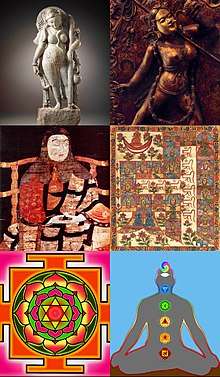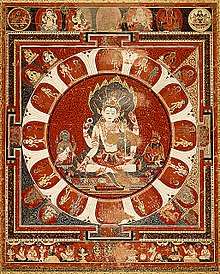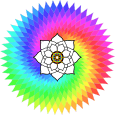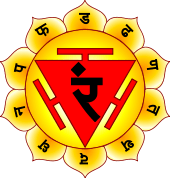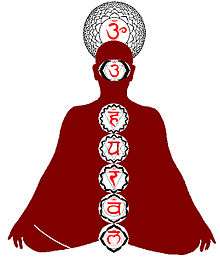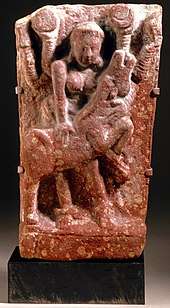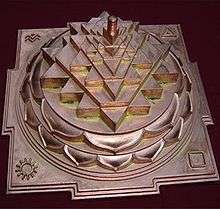Tantra
Tantra (/ˈtʌntrə, ˈtæn-/; Sanskrit: तन्त्र, literally "loom, weave, system") denotes the esoteric traditions of Hinduism and Buddhism that co-developed most likely about the middle of the 1st millennium AD. The term tantra, in the Indian traditions, also means any systematic broadly applicable "text, theory, system, method, instrument, technique or practice".[1][2]
| Part of a series on |
| Shaktism |
|---|
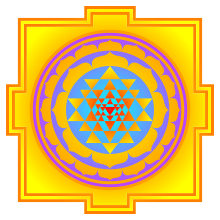 |
|
Schools |
|
Festivals and temples |
|
|
| Part of a series on |
| Vajrayana Buddhism |
|---|
 |
|
Traditions Historical traditions:
New branches:
|
|
History |
|
Pursuit |
|
Practices
Fourfold division: Twofold division: Thought forms and visualisation: Yoga:
|
|
Festivals |
|
Tantric texts |
|
Ordination and transmission |
Starting in the early centuries of common era, newly revealed Tantras centering on Vishnu, Shiva or Shakti emerged.[3] In Buddhism, the Vajrayana tradition is known for its extensive tantra ideas and practices.[4][5] Tantric Hindu and Buddhist traditions have influenced other Eastern religious traditions such as Jainism, the Tibetan Bön tradition, Daoism and the Japanese Shintō tradition.[6]
Certain modes of non-Vedic worship such as Puja are considered tantric in their conception and rituals. Hindu temple building also generally conforms to the iconography of tantra.[7][8] Hindu texts describing these topics are called Tantras, Āgamas or Samhitās.[9][10] In Buddhism, its tantra-genre literature has influenced the artworks in Tibet, historic cave temples of India and imagery in Southeast Asia.[11][12][13]
Etymology
Tantra (Sanskrit: तन्त्र) literally means "loom, warp, weave".[14][1][15]
The connotation of the word tantra to mean an esoteric practice or religious ritualism is a colonial era European invention.[16][17][18] This term is based on the metaphor of weaving, states Ron Barrett, where the Sanskrit root tan means the warping of threads on a loom.[1] It implies "interweaving of traditions and teachings as threads" into a text, technique or practice.[1][15]
The word appears in the hymns of the Rigveda such as in 10.71, with the meaning of "warp (weaving)".[14][19] It is found in many other Vedic era texts, such as in section 10.7.42 of the Atharvaveda and many Brahmanas.[14][20] In these and post-Vedic texts, the contextual meaning of Tantra is that which is "principal or essential part, main point, model, framework, feature".[14] In the Smritis and epics of Hinduism (and Jainism), the term means "doctrine, rule, theory, method, technique or chapter" and the word appears both as a separate word and as a common suffix, such as atma-tantra meaning "doctrine or theory of Atman (soul, self)".[14][20]
The term "Tantra" after about 500 BC, in Buddhism, Hinduism and Jainism is a bibliographic category, just like the word Sutra (which means "sewing together", mirroring the metaphor of "weaving together" in Tantra). The same Buddhist texts are sometimes referred to as tantra or sutra; for example, Vairocabhisambodhi-tantra is also referred to as Vairocabhisambodhi-sutra.[21] The various contextual meanings of the word Tantra vary with the Indian text and are summarized in the appended table.
| Period[note 1] | Text or author | Contextual meaning of tantra |
|---|---|---|
| 1700–1100 BC | Ṛgveda X, 71.9 | Loom (or weaving device)[22] |
| 1700-? BC | Sāmaveda, Tandya Brahmana | Essence (or "main part", perhaps denoting the quintessence of the Sastras)[22] |
| 1200-900 BC | Atharvaveda X, 7.42 | Loom (or weaving)[22] |
| 1400-1000 BC | Yajurveda, Taittiriya Brahmana 11.5.5.3 | Loom (or weaving)[22] |
| 600-500 BC | Pāṇini in Aṣṭādhyāyī 1.4.54 and 5.2.70 | Warp (weaving), loom[23] |
| pre-500 BC | Śatapatha Brāhmaṇa | Essence (or main part; see above)[22] |
| 350-283 BC | Chanakya on Arthaśāstra | Science;[24] system or shastra[25] |
| AD 300 | Īśvarakṛṣṇa author of Sānkhya Kārikā (kārikā 70) | Doctrine (identifies Sankhya as a tantra)[26] |
| AD 320 | Viṣṇu Purāṇa | Practices and rituals[27] |
| AD 320-400 | Poet Kālidāsa on Abhijñānaśākuntalam | Deep understanding or mastery of a topic[note 2] |
| 423 | Gangdhar stone inscription in Rajasthan | Worship techniques (Tantrodbhuta)[28] Dubious link to Tantric practices.[29] |
| 550 | Sabarasvamin's commentary on Mimamsa Sutra 11.1.1, 11.4.1 etc. | Thread, text;[30] beneficial action or thing[25] |
| 500-600 | Chinese Buddhist canon (Vol. 18–21: Tantra (Vajrayāna) or Tantric Buddhism[note 3] | Set of doctrines or practices |
| 600 | Kāmikāgama or Kāmikā-tantra | Extensive knowledge of principles of reality[31] |
| 606–647 | Sanskrit scholar and poet Bāṇabhaṭṭa (in Harṣacarita[note 4] and in Kādambari), in Bhāsa's Cārudatta and in Śūdraka's Mṛcchakatika | Set of sites and worship methods to goddesses or Matrikas.[28][32] |
| 975–1025 | Philosopher Abhinavagupta in his Tantrāloka | Set of doctrines or practices, teachings, texts, system (sometimes called Agamas)[33][15] |
| 1150–1200 | Jayaratha, Abhinavagupta's commentator on Tantrāloka | Set of doctrines or practices, teachings |
| 1690–1785 | Bhāskararāya (philosopher) | System of thought or set of doctrines or practices, a canon[34] |
Definition
Ancient and medieval era
The 5th-century BC scholar Pāṇini in his Sutra 1.4.54–55 of Sanskrit grammar, cryptically explains tantra through the example of "Sva-tantra" (Sanskrit: स्वतन्त्र), which he states means "independent" or a person who is his own "warp, cloth, weaver, promoter, karta (actor)".[23] Patanjali in his Mahābhāṣya quotes and accepts Panini's definition, then discusses or mentions it at a greater length, in 18 instances, stating that its metaphorical definition of "warp (weaving), extended cloth" is relevant to many contexts.[35] The word tantra, states Patanjali, means "principal, main".
He uses the same example of svatantra as a composite word of "sva" (self) and tantra, then stating "svatantra" means "one who is self-dependent, one who is his own master, the principal thing for whom is himself", thereby interpreting the definition of tantra.[23] Patanjali also offers a semantic definition of Tantra, stating that it is structural rules, standard procedures, centralized guide or knowledge in any field that applies to many elements.[35]
The ancient Mimamsa school of Hinduism uses the term tantra extensively, and its scholars offer various definitions. For example:
When an action or a thing, once complete, becomes beneficial in several matters to one person, or to many people, that is known as Tantra. For example, a lamp placed amidst many priests. In contrast, that which benefits by its repetition is called Āvāpa, such as massaging with oil. (...)
Medieval texts present their own definitions of Tantra. Kāmikā-tantra, for example, gives the following explanation of the term tantra:
Because it elaborates (tan) copious and profound matters, especially relating to the principles of reality (tattva) and sacred mantras, and because it provides liberation (tra), it is called a tantra.[31]
Modern era
The occultist and businessman Pierre Bernard (1875–1955) is widely credited with introducing the philosophy and practices of tantra to the American people, at the same time creating a misleading impression of its connection to sex.[37]
In modern scholarship, Tantra has been studied as an esoteric practice and ritualistic religion, sometimes referred to as Tantrism. There is a wide gap between what Tantra means to its followers, and the way Tantra has been represented or perceived since colonial era writers began commenting on it.[38] Many definitions of Tantra have been proposed since, and there is no universally accepted definition.[39] André Padoux, in his review of Tantra definitions offers two, then rejects both. One definition, due to Padoux, is found among Tantra practitioners — it is any "system of observances" about the vision of man and the cosmos where correspondences between the inner world of the person and the macrocosmic reality play an essential role. Another definition, more common among observers and non-practitioners, is some "set of mechanistic rituals, omitting entirely the ideological side".[40]
Tantric traditions have been studied mostly from textual and historical perspectives. Anthropological work on living Tantric tradition is scarce, and ethnography has rarely engaged with the study of Tantra. This is arguably a result of the modern construction of Tantrism as occult, esoteric and secret. Some scholars have tried to demystify the myth of secrecy in contemporary Tantric traditions, suggesting new methodological avenues to overcome the ethical and epistemological problems in the study of living Tantric traditions.[41]
According to David N. Lorenzen, two different kinds of definitions of Tantra exist, narrow and broad.[10] According to the narrow definition, Tantrism, or "Tantric religion", is the elite traditions directly based on the Sanskrit texts called the Tantras, Samhitas, and Agamas.[10][42] Lorenzen's "broad definition" extends this by including a broad range of "magical beliefs and practices" such as Yoga and Shaktism.[42][43]
Richard Payne states that Tantra has been commonly but incorrectly associated with sex, given popular culture's prurient obsession with intimacy. Tantra has been labelled as the "yoga of ecstasy", driven by senseless ritualistic libertinism.[21] This is far from the diverse and complex understanding of what Tantra means to those Buddhists, Hindu and Jains who practice it.[21]
David Gray disagrees with broad generalizations and states that defining Tantra is a difficult task because "Tantra traditions are manifold, spanning several religious traditions and cultural worlds. As a result they are also diverse, which makes it a significant challenge to come up with an adequate definition".[44] The challenge of defining Tantra is compounded by the fact that it has been a historically significant part of major Indian religions, including Buddhism, Hinduism and Jainism, both in and outside South Asia and East Asia.[45] To its practitioners, Tantra is defined as a combination of texts, techniques, rituals, monastic practices, meditation, yoga, and ideology.[46]
According to Georg Feuerstein, "The scope of topics discussed in the Tantras is considerable. They deal with the creation and history of the world; the names and functions of a great variety of male and female deities and other higher beings; the types of ritual worship (especially of Goddesses); magic, sorcery, and divination; esoteric "physiology" (the mapping of the subtle or psychic body); the awakening of the mysterious serpent power (kundalinî-shakti); techniques of bodily and mental purification; the nature of enlightenment; and not least, sacred sexuality."[47] Hindu puja, temples and iconography all show tantric influence.[7] These texts, states Gavin Flood, contain representation of "the body in philosophy, in ritual and in art", which are linked to "techniques of the body, methods or technologies developed within the tantric traditions intended to transform body and self".[48]
Tantrism
The term tantrism is a 19th-century European invention not present in any Asian language; [17] compare "Sufism", of similar Orientalist origin. According to Padoux, Tantrism is a Western term and notion, not a category that is used by the "Tantrists" themselves.[16][note 5] The term was introduced by 19th-century Indologists, with limited knowledge of India and in whose view Tantrism was a particular, unusual and minority practice in contrast to Indian traditions they believed to be mainstream.[16]
Robert Brown similarly notes that "tantrism" is a construct of Western scholarship, not a concept of the religious system itself.[51] He defines Tantrism as an apologetic label of Westerners for a system that they little understand that is "not coherent" and which is "an accumulated set of practices and ideas from various sources, that has varied between its practitioners within a group, varied across groups, across geography and over its history". It is a system, adds Brown, that gives each follower the freedom to mix Tantric elements with non-Tantric aspects, to challenge and transgress any and all norms, experiment with "the mundane to reach the supramundane".[52]
Teun Goudriaan in his 1981 review of Hindu Tantrism, states that Tantrism usually means a "systematic quest for salvation or spiritual excellence" by realizing and fostering the divine within one's own body, one that is simultaneous union of the masculine-feminine and spirit-matter, and has the ultimate goal of realizing the "primal blissful state of non-duality".[53] It is typically a methodically striven system, consisting of voluntarily chosen specific practices which may include Tantric items such as mantras (bijas), geometric patterns and symbols (mandala), gestures (mudra), mapping of the microcosm within one's body to the macrocosmic elements outside as the subtle body (kundalini yoga), assignments of icons and sounds (nyasa), meditation (dhyana), ritual worship (puja), initiation (diksha) and others.[54] Tantrism, adds Goudriaan, is a living system that is decidedly monistic, but with wide variations, and it is impossible to be dogmatic about a simple or fixed definition.[55]
Tantrism is an overarching term for "Tantric traditions", states David Gray in a 2016 review, that combine Vedic, yogic and meditative traditions from ancient Hinduism as well as rival Buddhist and Jain traditions.[38] it is a neologism of western scholars and does not reflect the self-understanding of any particular tantric tradition. While Goudriaan's description is useful, adds Gray, there is no single defining universal characteristic common to all Tantra traditions, being an open evolving system.[18] Tantrism, whether Buddhist or Hindu, can best be characterized as practices, a set of techniques, with a strong focus on rituals and meditation, by those who believe that it is a path to liberation that is characterized by both knowledge and freedom.[56]
Tantrika
According to Padoux, the term "Tantrika" is based on a comment by Kulluka Bhatta on Manava Dharmasastra 2.1, who contrasted vaidika and tantrika forms of Sruti (canonical texts). The Tantrika, to Bhatta, is that literature which forms a parallel part of the Hindu tradition, independent of the Vedic corpus. The Vedic and non-Vedic (Tantric) paths are seen as two different approaches to ultimate reality, the Vedic approach based on Brahman, and Tantrika being based on the non-Vedic Āgama texts.[57] Despite Bhatta attempt to clarify, states Padoux, in reality Hindus and Buddhists have historically felt free to borrow and blend ideas from all sources, Vedic, non-Vedic and in the case of Buddhism, its own canonical works.[58]
One of the key differences between the Tantric and non-Tantric traditions – whether it be orthodox Buddhism, Hinduism or Jainism – is their assumptions about the need for monastic or ascetic life.[59] Non-Tantrika, or orthodox traditions in all three major ancient Indian religions, hold that the worldly life of a householder is one driven by desires and greeds which are a serious impediment to spiritual liberation (moksha, nirvana, kaivalya). These orthodox traditions teach renunciation of householder life, a mendicant's life of simplicity and leaving all attachments to become a monk or nun. In contrast, the Tantrika traditions hold, states Robert Brown, that "both enlightenment and worldly success" are achievable, and that "this world need not be shunned to achieve enlightenment".[59][60]
History
Vedic texts
The Keśin hymn of the Rig Veda (10.136) describes the "wild loner" who, states Karel Werner, "carrying within oneself fire and poison, heaven and earth, ranging from enthusiasm and creativity to depression and agony, from the heights of spiritual bliss to the heaviness of earth-bound labor".[61] The Rigveda uses words of admiration for these loners,[61] and whether it is related to Tantra or not, has been variously interpreted. According to David Lorenzen, it describes munis (sages) experiencing Tantra-like "ecstatic, altered states of consciousness" and gaining the ability "to fly on the wind".[62] In contrast, Werner suggests that these are early Yoga pioneers and accomplished yogis of the ancient pre-Buddhist Indian tradition, and that this Vedic hymn is speaking of those "lost in thoughts" whose "personalities are not bound to earth, for they follow the path of the mysterious wind".[61]
The two oldest Upanishadic scriptures of Hinduism, the Brihadaranyaka Upanishad in section 4.2 and Chandogya Upanishad in section 8.6, refer to nadis (hati) in presenting their theory on how the Atman (soul) and the body are connected and interdependent through energy carrying arteries when one is awake or sleeping, but they do not mention anything related to Tantric practices.[63][64] The Shvetashvatara Upanishad describes breath control that became a standard part of Yoga, but Tantric practices do not appear in it.[62][65] The Yoga Sutras of Patanjali are an early codification of Yogic practices.[66] Later, according to Lorenzen, these early Yoga-related ideas develop into Hatha Yoga, and then diversify into the "mystical anatomy" of nadis and chakras of Tantric practices.[67] The 7th-century shamanic-yogic component of Tantrism appears clearly in Tantric form in Bāṇabhaṭṭa's Harshacharita and Daṇḍin's Dashakumaracharita.[68] In contrast to this theory of Lorenzen, other scholars such as Mircea Eliade consider Yoga and the evolution of Yogic practices to be separate and distinct from the evolution of Tantra and Tantric practices.[69]
David Gordon White views Yogini cults as foundational to early tantra but disputes scholars who see their roots in an "autochthonous non-Vedic source" such indigenous tribes or the Indus Valley Civilization.[70] Instead, White suggests Vedic Srauta texts mention offerings to goddesses Rākā, Sinīvālī, and Kuhū in a manner similar to a tantric ritual.[71] Frederick Smith – a professor of Sanskrit and Classical Indian Religions, views Tantra to be a parallel religious movement to Bhakti movement of the 1st millennium AD.[72] Tantra along with Ayurveda, states Smith, has traditionally been attributed to Atharvaveda, but this attribution is one of respect not of historicity. Ayurveda has primarily been an empirical practice with Vedic roots, but Tantra has been an esoteric, folk movement without grounding that can be traced to anything in Atharvaveda or any other vedic text.[72]
Buddhist reliefs
A series of artwork discovered in Gandhara, in modern-day Pakistan, dated to be from about 1st century AD, show Buddhist and Hindu monks holding skulls. One of them shows the Buddha sitting in the center; on one side sits a Buddhist monk and on the other side sits a Hindu monk.[73] The legend corresponding to these artworks is found in Buddhist texts, and describes monks "who tap skulls and forecast the future rebirths of the person to whom that skull belonged".[73][74] According to Robert Brown, these Buddhist skull-tapping reliefs suggest tantric practices may have been vogue by the 1st century AD to appear prominently in Buddhist art and its texts.[73]
Durga
The Mahabharata, the Harivamsa, the Devi Mahatmya in the Markandeya Purana all contain references to the fierce, demon-killing manifestations of the Great Goddess, Mahishamardini, who is identified with Durga-Parvati.[77] These suggest reverence and worship for Goddess in the India culture was an established tradition (Shaktism), by the early centuries of the 1st millennium.[78] However, this does not mean Tantric rituals and practices were as yet a part of either Hindu or Buddhist traditions. "Apart from the somewhat dubious reference to Tantra in the Gangadhar inscription of 423 CE", states David Lorenzen, it is only 7th-century Banabhatta's Kadambari which provide convincing proof of Tantra and Tantric texts.[29]
Tantra texts
According to Flood, the earliest date for the Tantra texts related to Tantric practices is AD 600, though most of them were probably composed after the 8th century onwards.[79] By the 10th century an extensive corpus existed.[79] Regionally, the tantric texts were mostly composed during this period in Kashmir and Nepal.[80] They were also called agamas in Shaivism, samhita or Pancaratra in Vaishnavism, and as tantras in Shaktism.[81] The Buddhists developed their own corpus of Tantras, which became the textual basis of Vajrayana.[79] In Jainism, secondary texts suggest a substantial Tantra corpus based on the Surya tradition developed in the western regions of India, but complete manuscripts of these have not survived into the modern era.[81] Among the Hindus, those belonging to the Vedic orthodox traditions rejected the Tantra texts, the Tantric followers incorporated the Vedic ideas within their own systems considering the Tantras as the higher, refined understanding of older ideas.[81] Some considered the Tantra texts to be superior to the Vedas, while others considered them complementary:
The Veda is the cow, the true Agama its milk.
— Umapati, Translated by David Smith[82]
According to Flood, very little is known about who created the Tantras, nor much is known about the social status of these and medieval era Tantrikas.[83] The Tantra pioneers may have been ascetics who lived at the cremation grounds, possibly from "above low-caste groups" states Flood, and these were probably non-Brahmanical.[84] These Hindu renouncers and ascetics trace back to far more ancient traditions,[85][86] and they are mentioned in the Buddhist Pali canon.[83] By the early medieval times, their practices may have included the imitation of the deities such as goddess Kali and god Bhairava, with offerings of non-vegetarian food, alcohol and sexual substances. According to this theory, these practitioners would have invited their deities to avesha mam (enter me), then reverted the role in order to control that deity and gain its power.[83] These ascetics would have been supported by low castes living at the cremation places.[83]
Tantric practices
The early Tantric practices in Indian history are sometimes attributed to the Kapalikas (literally, "skull men", also called Somasiddhatins or Mahavartins).[87][88] Little, however, is reliably known about them, and there is a paucity of primary sources on Kapalikas.[89] The historical information about them is primarily available from dubious fictional works and the disparaging remarks made about them in the Buddhist, Hindu and Jain texts of the 1st millennium AD.[89][90]
In Hāla’s Gatha-saptasati (composed by the 5th century AD), for example, the story calls a female character Kapalika, whose lover dies, he is cremated, she takes his cremation ashes and smears her body with it.[88] The 6th-century Varāhamihira mentions Kapalikas in his literary works.[90] Some of the Kāpālika practices mentioned in these texts are those found in Shaiva Hinduism and Vajrayana Buddhism, and scholars disagree on who influenced whom.[91][92]
These early historical mentions are in passing and appear to be Tantra-like practices, they are not detailed nor comprehensive presentation of Tantric beliefs and practices. Epigraphic references to the Kaulas Tantric practices are rare. Reference is made in the early 9th century to vama (left-hand) Tantras of the Kaulas.[93] Literary evidence suggests Tantric Buddhism was probably flourishing by the 7th-century.[62] Matrikas, or fierce mother goddesses that later are closely linked to Tantra practices, appear both in Buddhist and Hindu arts and literature between the 7th and 10th centuries.[94]
Traction and growth
Tantra probably gained traction after 6th century, post-Gupta Empire era.[99][17] Tantric practices were known by the 7th century, flourished between the 8th or 9th century and the 14th century.[100]
Major Tantric texts had been written by the 10th century, particularly in Kashmir, Nepal and Bengal. By the 10th or 11th century, Tantric texts had been translated into regional languages such as Tamil, and Tantric practices probably had spread across South Asia.[80] It was broadly influential, with Flood describing it as follows:
Tantrism has been so pervasive that all of Hinduism after the eleventh century, perhaps with the exception of the vedic Srauta tradition, is influenced by it. All forms of Saiva, Vaisnava and Smarta religion, even those forms which wanted to distance themselves from Tantrism, absorbed elements derived from the Tantras.
— Gavin Flood, An Introduction to Hinduism[80]
The 13th-century Dvaita Vedanta philosopher Madhvacharya wrote copious commentaries on then existing major schools of Indian philosophies and practices, and cited the works of the 10th century Abhinavagupta considered as a major and influential Tantra scholar.[101] However, Madhvacharya does not mention Tantra as a separate, distinct religious or ritual-driven practice. The early 20th-century Indian scholar Pandurang Vaman Kane conjectured that Madhvacharya ignored Tantra because it may have been considered scandalous. In contrast, Padoux suggests that Tantra may have been so pervasive by the 13th century that "it was not regarded as being a distinct system."[101]
Tantrism further spread with the silk road transmission of Buddhism to East and Southeast Asia,[102] and also influenced the Bön tradition of Tibet.[102]
Sex and eroticism
The Tantra texts and tantric practices involve a wide range of topics, mostly focused on spiritual topics, and not of a sexual nature. However, states Gavin Flood, Tantrism is more known in the West as being notorious for its antinomian elements, stereotypically portrayed as a practice that is esoteric eroticism and ritualized sex in the name of religion, one imbued with alcohol and offering of meat to fierce deities.[103][104] This portrayal is not limited to the Western imagination, however. Jayanta Bhatta, the 9th-century scholar of the Nyaya school of Hindu philosophy and who commented on Tantra literature, stated that the Tantric ideas and spiritual practices are mostly well placed, but it also has "immoral teachings" such as by the so-called "Nilambara" sect where its practitioners "wear simply one blue garment, and then as a group engage in unconstrained public sex" on festivals. He wrote, this practice is unnecessary and it threatens fundamental values of society.[105]
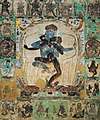
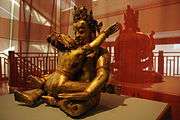
Sexuality has been a part of Tantric practices, sexual fluids have been viewed as "power substances" and used ritualistically. Some extreme texts, states Flood, go further such as the Buddhist text Candamaharosana-tantra advocating consumption of bodily waste products as "power substances", teaching the waste should be consumed as a diet "eaten by all the Buddhas" without slightest disgust.[107] However, such esoteric practices are exceptional and extreme, they are not found in much of Buddhist and Hindu Tantric literature or practices. In the Kaula tradition and others where sexual fluids as power substances and ritual sex are mentioned, scholars disagree in their translations, interpretations and practical significance.[108][109][110]
Douglas Renfrew Brooks, for example, states that the antinomian elements such as the use of intoxicating substances and sex were not animistic, but were adopted in some Kaula traditions to challenge the Tantric devotee to break down the "distinctions between the ultimate reality of Brahman and the mundane physical and mundane world". By combining erotic and ascetic techniques, states Brooks, the Tantric broke down all social and internal assumptions, became Shiva-like.[111] In Kashmir Shaivism, states David Gray, the antinomian transgressive ideas were internalized, for meditation and reflection, and as a means to "realize a transcendent subjectivity".[112]
In most Hindu and Buddhist Tantra texts, extreme forms of sexual ritualism is absent. In Jain tantric text, this is entirely absent.[113] Yet, emotions, eroticism and sex are universally regarded in Tantric literature as natural, desirable, a means of transformation of the deity within, to "reflect and recapitulate the bliss of Shiva and Shakti". Kama and sex is another aspect of life and a "root of the universe", in the Tantric view, whose purpose extends beyond procreation and is another means to spiritual journey and fulfillment.[114] This idea flowers with the inclusion of kama art in Hindu temple arts, and its various temple architecture and design manuals such as the Shilpa-prakasha by the Hindu scholar Ramachandra Kulacara.[114]
| A quote from a Tantra text on Hindu temple arts, sex and eroticism | |
|---|---|
|
 Kamabandha (erotic sculpture) at Khajuraho temple according to Kamakala Tattva in Silpasastra, a Tantra text.[117] |
| For an alternate and complete translation: Alice Boner's Silpa Prakasa Medieval Orissan Sanskrit Text on Temple Architecture, Translated and Annotated.[118] | |
Practices
Rituals are the main focus of the Tantras.[119][note 6] Rather than one coherent system, Tantra is an accumulation of practices and ideas. Because of the wide range of communities covered by the term, it is problematic to describe tantric practices definitively.
Components
André Padoux notes that there is no consensus among scholars as to which elements are characteristic for Tantra, nor is there any text that contains all those elements.[120] Also, most of those elements can also be found in non-Tantric traditions.[120] According to Anthony Tribe, a scholar of Buddhist Tantra, Tantra has the following defining features:[121]
- Centrality of ritual, especially the worship of deities
- Centrality of mantras
- Visualisation of and identification with a deity
- Need for initiation, esotericism and secrecy
- Importance of a teacher (guru, acharya)
- Ritual use of mandalas (maṇḍala)
- Transgressive or antinomian acts
- Revaluation of the body
- Revaluation of the status and role of women
- Analogical thinking (including microcosmic or macrocosmic correlation)
- Revaluation of negative mental states
According to David N. Lorenzen, Tantra practices include the following:[62]
Sadhanas
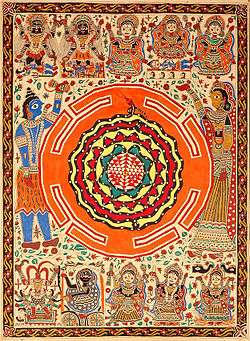
A number of techniques (sadhana) are used as aids for meditation and achieving spiritual power:[122]
- Dakshina: Donation or gift to one's teacher
- Diksha: Initiation ritual which may include shaktipat
- Yoga, including breathing techniques (pranayama) and postures (asana), is employed to balance the energies in the body/mind.
- Mudras, or hand gestures
- Mantras: reciting syllables, words, and phrases
- Singing of hymns of praise (stava)
- Mandalas
- Yantras: symbolic diagrams of forces at work in the universe
- Visualization of deities and Identification with deities
- Puja (worship ritual)
- Animal sacrifice
- Use of taboo substances such as alcohol, cannabis, meat and other entheogens.
- Prāyaścitta - an expiation ritual performed if a puja has been performed wrongly
- Nyasa
- Ritual purification (of idols, of one's body, etc.)
- Guru bhakti (devotion) and puja
- Yatra: pilgrimage, processions
- Vrata: vows, sometimes to do ascetic practices like fasting
- The acquisition and use of siddhis or supernormal powers. Associated with the left hand path tantra.
- Ganachakra: A ritual feast during which a sacramental meal is offered.
- Ritual Music and Dance.
- Maithuna: ritual sexual union (with an actual physical consort).
- Dream yoga
Mandalas
According to David Gordon White, mandalas are a key element of Tantra.[123] They represent the constant flow and interaction of both divine, demonic, human and animal energy or impulses (kleshas, cetanā, taṇhā) in the universe. The mandala is a mesocosm, which mediates between the "transcendent-yet-immanent" macrocosm and the microcosm of mundane human experience.[123] The godhead is at the center of the mandala, while all other beings, including the practitioner, are located at various distances from this center.[123] Mandalas also reflected the medieval feudal system, with the king at its centre.[124]
The godhead is both transcendent and immanent, and the world is regarded as real, and not as an illusion. The goal is not to transcend the world, but to realize that the world is the manifestation of the godhead, while the "I" is "the supreme egoity of the godhead."[123] The world is to be seen with the eyes of the godhead, realizing that it is a manifestation as oneself.[125] The totality of all that is a "realm of Dharma" which shares a common principle.[126] The supreme is manifest in everyone, which is to be realized through Tantric practice.[126]
Mantra, yantra, nyasa
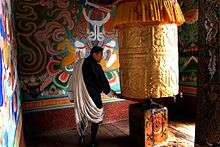
The words mantram, tantram and yantram are rooted linguistically and phonologically in ancient Indian traditions. Mantram denotes the chant, or "knowledge." Tantram denotes philosophy, or ritual actions. Yantram denotes the means by which a person is expected to lead their life.
The mantra and yantra are instruments to invoke higher qualities, often associated with specific Hindu deities such as Shiva, Shakti, or Kali. Similarly, puja may involve focusing on a yantra or mandala associated with a deity.[127]
Each mantra is associated with a specific Nyasa. Nyasa involves touching various parts of the body at specific parts of the mantra, thought to invoke the deity in the body. There are several types of Nyasas; the most important are Kara Nyasa and Anga Nyasa.
Identification with deities
Visualisation
The deities are internalised as attributes of Ishta devata meditations, with practitioners visualizing themselves as the deity or experiencing the darshan (vision) of the deity. During meditation the initiate identifies with any of the Hindu gods and goddesses, visualising and internalising them in a process similar to sexual courtship and consummation.[128] The Tantrika practitioner may use visualizations of deities, identifying with a deity to the degree that the aspirant "becomes" the Ishta-deva (or meditational deity).[129]
Classes of devotees
In Hindu Tantra, uniting the deity and the devotee uses meditation and ritual practices. These practices are divided among three classes of devotees: the animal, heroic, and the divine. In the divine devotee, the rituals are internal. The divine devotee is the only one who can attain the object of the rituals (awakening energy).[130]
Hinduism
| Part of a series on |
| Shaivism |
|---|
 |
|
Scriptures and texts
|
|
Philosophy
|
|
Practices |
|
Schools
Saiddhantika Non - Saiddhantika
|
|
Related
|
In Hinduism, the tantric traditions are found in Shaivism's Shaiva Siddhanta and the Mantrapīṭha (Bhairava-centred), and in Shaktism's Vidyāpīṭha and the Kulamārga traditions.[131]
The Tantra texts of the Vaishnava tradition are the Pancharatra, and typically called the Agamas in the Vaishnava traditions. The term "Tantra" in Hindu genre of literature is usually used specifically to refer to Shakta Agamas.[132][133] The Agamas literature is voluminous, and includes 28 Shaiva Agamas, 77 Shakta Agamas (also called Tantras), and 108 Vaishnava Agamas (also called Pancharatra Samhitas), and numerous Upa-Agamas.[134]
Some Tantra texts in Hinduism are Vedic and others non-Vedic.[135] Agama traditions include Yoga and Self Realization concepts, some include Kundalini Yoga,[136] asceticism, and philosophies ranging from Dvaita (dualism) to Advaita (monism).[137][138]
The means of worship in the Hindu Tantric practice differs from the Vedic form. While the Vedic practice of yajna there are no idols and shrines, in its Tantric traditions, idols and symbolic icons with puja are the means of worship.[139] Temples, symbolism, icons that remind the devotee of attributes and values are a necessary part of the Agamic practice, while non-theistic paths are one of the many alternative means in the Vedic practice.[139] This, however, does not necessarily mean that Tantra-Agamas and Vedas are opposed, according to medieval era Hindu theologians. Tirumular, for example, explained their link as, "the Vedas are the path, and the Agamas are the horse".[139][140]
Each Tantra-Agama text consists of four parts:[137][139]
- Jnana pada, also called Vidya pada[137] – consists of doctrine, the philosophical and spiritual knowledge, knowledge of reality and liberation.
- Yoga pada - precepts on yoga, the physical and mental discipline.
- Kriya pada - consists of rules for rituals, construction of temples (Mandir); design principles for sculpting, carving, and consecration of idols of deities for worship in temples;[141] for different forms of initiations or diksha. This code is analogous to those in Puranas and in the Buddhist text of Sadhanamala.[137]
- Charya pada - lays down rules of conduct, of worship (puja), observances of religious rites, rituals, festivals and prayaschittas.
The Tantra-Agama texts of Hinduism present a diverse range of philosophies, ranging from theistic dualism to absolute monism.[138][142] This diversity of views was acknowledged in Chapter 36 of Tantraloka, the 10th century scholar Abhinavagupta.[138] In Shaivism alone, there are ten dualistic (dvaita) Agama texts, eighteen qualified monism-cum-dualism (bhedabheda) Agama texts, and sixty four monism (advaita) Agama texts.[143] The Bhairava Shastras are monistic Tantra texts, while Shiva Shastras are dualistic.[144][145]
Buddhism
| Part of a series on |
| Vajrayana Buddhism |
|---|
 |
|
Traditions Historical traditions:
New branches:
|
|
History |
|
Pursuit |
|
Practices
Fourfold division: Twofold division: Thought forms and visualisation: Yoga:
|
|
Festivals |
|
Tantric texts |
|
Ordination and transmission |
Many tantric traditions developed within Buddhism, over its history in South Asia and East Asia.[146][147][148] These are also called the Vajrayana traditions.[149] The tradition has been particularly prevalent in Tibet and Nepal.[146] The Buddhist Tantric practices and texts, states Jacob Dalton, developed between the 5th and the 7th centuries and this is evidenced by Chinese Buddhist translations of Indian texts from that period preserved in Dunhuang.[146] Ryan Overbey too affirms this, stating that Buddhist Tantric spells and ritual texts were translated by Chinese Buddhist scholars six times and these spells appear in multiple texts between the 5th and 8th centuries.[150]
According to Alexis Sanderson, various classes of Vajrayana literature developed as a result of royal courts sponsoring both Buddhism and Saivism.[151] The Mañjusrimulakalpa, which later came to classified under Kriyatantra, states that mantras taught in the Shaiva, Garuda and Vaishnava tantras will be effective if applied by Buddhists since they were all taught originally by Manjushri.[152] The Guhyasiddhi of Padmavajra, a work associated with the Guhyasamaja tradition, prescribes acting as a Shaiva guru and initiating members into Saiva Siddhanta scriptures and mandalas.[153] The Samvara tantra texts adopted the pitha list from the Shaiva text Tantrasadbhava, introducing a copying error where a deity was mistaken for a place.[154]
Jainism and other religions
The Tantric traditions of Hinduism and Buddhism spread rapidly within India and Tibet, and from there to Southeast Asia, East Asia and Central Asia.[155] They significantly influenced many other religious traditions such Jainism, Sikhism, the Tibetan Bön tradition, Daoism, and the Japanese Shintō tradition.[156][157][158] In the Sikh literature, the ideas related to Shakti and goddess reverence attributed to Guru Gobind Singh, particularly in the Dasam Granth, are related to tantra ideas found in Buddhism and Hinduism.[159]
The Jain worship methods, states Ellen Gough, were likely influenced by Shaktism ideas, and this is attested by the tantric diagrams of the Rishi-mandala where the Tirthankaras are portrayed.[160] The Tantric traditions within Jainism use verbal spells or mantra, and rituals that are believed to accrue merit for rebirth realms.[161]
Western scholarly research
John Woodroffe
The first Western scholar to seriously study Tantra was John Woodroffe (1865–1936), who wrote about Tantra under the pen name Arthur Avalon and is known as the "founding father of Tantric studies".[162] Unlike previous Western scholars Woodroffe advocated for Tantra, defending and presenting it as an ethical and philosophical system in accord with the Vedas and Vedanta.[163] Woodroffe practised Tantra and, while trying to maintain scholastic objectivity, was a student of Hindu Tantra (the Shiva-Shakta tradition).[164]
Further development
Following Woodroffe, a number of scholars began investigating Tantric teachings, including scholars of comparative religion and Indology such as Agehananda Bharati, Mircea Eliade, Julius Evola, Carl Jung, Alexandra David-Néel, Giuseppe Tucci and Heinrich Zimmer.[165] According to Hugh Urban, Zimmer, Evola and Eliade viewed Tantra as "the culmination of all Indian thought: the most radical form of spirituality and the archaic heart of aboriginal India", regarding it as the ideal religion for the modern era. All three saw Tantra as "the most transgressive and violent path to the sacred".[166] Practitioners such as Jaya Yogacharya (Reunion island, Indian Ocean) asserts that the practice of tantra yoga transforms oneself and therefore invites to change one's positioning in life.[167]
See also
Notes
- The dates in the left column of the table are estimates and contested by scholars.
- Sures Chandra Banerjee, says [Banerjee, S.C., 1988]: "Tantra is sometimes used to denote governance. Kālidāsa uses the expression prajah tantrayitva (having governed the subjects) in the Abhijñānaśākuntalam (V.5).
- Also known as Tantrayāna, Mantrayāna, Esoteric Buddhism and the Diamond Vehicle.
- "Banabhatta, the Sanskrit author of the 7th century, refers, in the Harshacharita to the propitiation of Matrikas by a tantric ascetic."[32]
- Tantric texts are also often not being called "Tantras."[16]
- Compare Joel Andre-Michel Dubois (2013), The Hidden Lives of Brahman, page xvii-xviii, who notes that Adi Shankara provides powerful analogies with the Vedic fire-ritual in his Upanishadic commentaries.
References
- Ron Barrett (2008). Aghor Medicine. University of California Press. p. 12. ISBN 978-0-520-25218-9.
- Flood 2006, pp. 9–14.
- Flood 2006, p. 7-8.
- Flood 2006, pp. 9, 107.
- Geshe Kelsang Gyatso (2000). Essence of Vajrayana: The Highest Yoga Tantra Practice of Heruka Body Mandala. Motilal Banarsidass. pp. x, 5–7. ISBN 978-81-208-1729-6.
- Gray 2016, pp. 1–2, 17–19.
- Padoux 2013, p. 2. "The Hindu worship, the pūjā, for instance, is Tantric in its conception and ritual process, the principles of Hindu temple building and iconography are Tantric, and so on."
- Flood 2006, p. 53,73-75,79,81-3,99,132-3,177.
- Padoux 2013, p. 1.
- Lorenzen 2002, p. 25.
- Robert Beer (2003). The Handbook of Tibetan Buddhist Symbols. Serindia Publications. pp. xi–xiv. ISBN 978-1-932476-03-3.
- Carmel Berkson (1986). The caves at Aurangabad: early Buddhist Tantric art in India. Mapin. pp. 11–12.
- Sylvia Fraser-Lu; Donald M. Stadtner (2015). Buddhist Art of Myanmar. Yale University Press. p. 59. ISBN 978-0-300-20945-7.
- Sir Monier Monier-Williams; Ernst Leumann; Carl Cappeller (2002). A Sanskrit-English Dictionary: Etymologically and Philologically Arranged with Special Reference to Cognate Indo-European Languages. Motilal Banarsidass (Reprint of Oxford University Press 1899 version). p. 436. ISBN 978-81-208-3105-6.
- Gavin Flood (2006). The Tantric Body: The Secret Tradition of Hindu Religion. I.B.Tauris. p. 9. ISBN 978-1-84511-011-6.
- Padoux 2002, p. 17.
- White 2005, p. 8984.
- Gray 2016, pp. 3-4.
- ऋग्वेद: सूक्तं १०.७१, Wikisource, Quote: "इमे ये नार्वाङ्न परश्चरन्ति न ब्राह्मणासो न सुतेकरासः । त एते वाचमभिपद्य पापया सिरीस्तन्त्रं तन्वते अप्रजज्ञयः ॥९॥"
- Hugh B. Urban (2008). Tantra: Sex, Secrecy, Politics, and Power in the Study of Religion. Motilal Banarsidass. pp. 26–27. ISBN 978-81-208-2932-9.
- Susan M. Felch (2016). The Cambridge Companion to Literature and Religion. Cambridge University Press. pp. 174–175. ISBN 978-1-316-75726-0.
- Banerjee 1988.
- Tiziana Pontillo; Maria Piera Candotti (2014). Signless Signification in Ancient India and Beyond. Anthem Press. pp. 47–48 with footnotes. ISBN 978-1-78308-332-9.
- Kauṭalya; R. P. Kangle (1986). The Kautiliya Arthasastra. Motilal Banarsidass. pp. 512 with footnote. ISBN 978-81-208-0042-7.
- Lal Mani Joshi (1977). Studies in the Buddhistic Culture of India During the 7th and 8th Centuries A.D. Motilal Banarsidass. p. 409. ISBN 978-81-208-0281-0.
- Bagchi 1989, p. 6.
- Banerjee 1988, p. 8.
- Katherine Anne Harper; Robert L. Brown (2012). The Roots of Tantra. State University of New York Press. pp. 48–50. ISBN 978-0-7914-8890-4.
- Lorenzen 2002, pp. 31-32.
- Hartmut Scharfe (1977). Grammatical Literature. Otto Harrassowitz Verlag. pp. 87 with footnote 50. ISBN 978-3-447-01706-0.
- Wallis 2012, p. 26.
- Banerjee 2002, p. 34.
- Mark S. G. Dyczkowski (1989). The Doctrine of Vibration: An Analysis of the Doctrines and Practices of Kashmir Shaivism. Motilal Banarsidass. pp. 4–5. ISBN 978-81-208-0596-5.
- Douglas Renfrew Brooks (1990). The Secret of the Three Cities: An Introduction to Hindu Sakta Tantrism. University of Chicago Press. pp. 16–17. ISBN 978-0-226-07569-3.
- Tiziana Pontillo; Maria Piera Candotti (2014). Signless Signification in Ancient India and Beyond. Anthem Press. pp. 48–61 with footnotes. ISBN 978-1-78308-332-9.
- Tiziana Pontillo; Maria Piera Candotti (2014). Signless Signification in Ancient India and Beyond. Anthem Press. pp. 89–90 with footnotes. ISBN 978-1-78308-332-9.
- Stirling, Isabel (2006). Zen Pioneer: The Life & Works of Ruth Fuller Sasaki. Counterpoint. p. 7. ISBN 978-1593761707.
- Gray 2016, pp. 1-2.
- Brown 2002, pp. 1-2.
- Brown 2002, pp. 5-6.
- Lorea, Carola; Lorea, Carola Erika (25 May 2018). ""I Am Afraid of Telling You This, Lest You'd Be Scared Shitless!": The Myth of Secrecy and the Study of the Esoteric Traditions of Bengal". Religions. 9 (6): 172. doi:10.3390/rel9060172.
- Brown 2002, p. 6.
- Lorenzen 2002, p. 25-26.
- Gray 2016, p. 3.
- Gray 2016, pp. 1-5.
- Gray 2016, pp. 1-8.
- Feuerstein, Georg. The Yoga Tradition: Its History, Literature, Philosophy and Practice (Kindle Locations 11501-11505). Hohm Press. Kindle Edition.
- Flood 2006, p. 4, 21-22, 172-173.
- Richard K. Payne (2006). Tantric Buddhism in East Asia. Simon and Schuster. pp. 130–131. ISBN 978-0-86171-487-2.
- Teun Goudriaan 1981, pp. 1-8.
- Harper & Brown 2002, p. 1.
- Harper & Brown 2002, pp. 1-2.
- Teun Goudriaan 1981, pp. 1-2, 39-40.
- Teun Goudriaan 1981, pp. 1-2, 198-200.
- Teun Goudriaan 1981, pp. 2, 7-8.
- Gray 2016, pp. 4-5.
- Padoux 2002, pp. 18-19.
- Padoux 2002, pp. 18-21.
- Brown 2002, pp. 3-4.
- Geoffrey Samuel; Jay Johnston, eds. (2013). Religion and the Subtle Body in Asia and the West: Between Mind and Body. Routledge. pp. 35–38. ISBN 978-1-136-76640-4.
- Werner, Karel (1977). "Yoga and the Ṛg Veda: An Interpretation of the Keśin Hymn (RV 10, 136)". Religious Studies. 13 (3): 289–302. doi:10.1017/S0034412500010076.
- Lorenzen 2002, p. 27.
- Stephen Phillips (2009). Yoga, Karma, and Rebirth: A Brief History and Philosophy. Columbia University Press. pp. 295 with note 23. ISBN 978-0-231-14485-8.
- Birendra N. Mallick; S. R. Pandi-Perumal; Robert W. McCarley; et al. (2011). Rapid Eye Movement Sleep: Regulation and Function. Cambridge University Press. p. 24. ISBN 978-1-139-50378-5.
- Paul Deussen, Sixty Upanishads of the Veda, Volume 1, Motilal Banarsidass, ISBN 978-8120814684, pages 301-304, 310-311
- David N. Lorenzen (2006). Who Invented Hinduism: Essays on Religion in History. Yoda Press. p. 68. ISBN 978-81-902272-6-1.
- Lorenzen 2002, p. 27-28.
- Lorenzen 2002, p. 28.
- David Gordon White (2014). The "Yoga Sutra of Patanjali": A Biography. Princeton University Press. p. 188. ISBN 978-1-4008-5005-1.
- White 2003, pp. 28-29.
- White 2003, pp. 30, 280.
- Frederick M. Smith (2012). The Self Possessed: Deity and Spirit Possession in South Asian Literature and Civilization. Columbia University Press. pp. 363–364. ISBN 978-0-231-51065-3.
- Brown 2002, pp. 11-13.
- Maurizio Taddei (1979), "The Story of the Buddha and the Skull-Tapper, A Note in Gandharan Iconography", Annali, Istituto Orientale di Napoli Roma, Volume 39, Number 3, pages 395-420
- Pratapaditya Pal; Los Angeles County Museum of Art (1986). Indian Sculpture: Circa 500 B.C.-A.D. 700. University of California Press. p. 27. ISBN 978-0-520-05991-7.
- Lorenzen 2002, pp. 28-32.
- Lorenzen 2002, pp. 28-30.
- Lorenzen 2002, pp. 28-29.
- Flood 1996, p. 158.
- Flood 1996, p. 159.
- Flood 1996, pp. 158-159.
- David Smith (1996), The Dance of Siva: Religion, Art and Poetry in South India, Cambridge University Press, ISBN 978-0-521-48234-9, page 116
- Flood 1996, p. 161.
- Flood 1996, pp. 161-162.
- Olivelle, Patrick (1992). The Samnyasa Upanisads. Oxford University Press. pp. 5–9, 17–18. ISBN 978-0-19-507045-3.
- Olivelle, Patrick (2011). Ascetics and Brahmins studies in ideologies and institutions. London New York: Anthem Press. ISBN 978-0-85728-432-7.
- Lorenzen 2002, p. 30.
- Mark S. G. Dyczkowski (1988). The Canon of the Saivagama and the Kubjika: Tantras of the Western Kaula Tradition. State University of New York Press. pp. 26–27. ISBN 978-0-88706-494-4.
- David N. Lorenzen (1972). The Kāpālikas and Kālāmukhas: Two Lost Śaivite Sects. University of California Press. p. xii, 1–4. ISBN 978-0-520-01842-6.
- Lorenzen 2002, pp. 30-31.
- Ronald Davidson (2002), Indian Esoteric Buddhism, Columbia University Press. pages 202-218
- Alexis Sanderson (2014), The Śaiva Literature, Journal of Indological Studies (Kyoto), Nos. 24 & 25, pages 4–5, 11, 57.
- Lorenzen 2002, p. 31.
- Lorenzen 2002, pp. 27-31.
- Peter Alan Roberts (2011). Mahamudra and Related Instructions: Core Teachings of the Kagyu Schools. Simon and Schuster. p. 715. ISBN 978-0-86171-444-5.
- István Keul (2012). Transformations and Transfer of Tantra in Asia and Beyond. Walter de Gruyter. pp. 119–123. ISBN 978-3-11-025811-0.
- Pia Brancaccio (2010). The Buddhist Caves at Aurangabad: Transformations in Art and Religion. BRILL Academic. pp. 21, 202–207. ISBN 978-90-04-18525-8., Quote: "To the right of the main Buddha image, carved out of the wall of the sanctum, is an ensemble of seven female images".
- David B. Gray; Ryan Richard Overbey (2016). Tantric Traditions in Transmission and Translation. Oxford University Press. pp. 47–48. ISBN 978-0-19-990952-0.
- Einoo 2009, p. 45.
- Smith 2005, p. 8989.
- Padoux 2002, pp. 17-18.
- White 2000, p. 7.
- Flood 1996, pp. 159-160.
- Flood 2006, pp. i-ii.
- Flood 2006, pp. 48-49.
- Roderick Whitfield; Susan Whitfield; Neville Agnew (2015). Cave Temples of Mogao at Dunhuang: Art History on the Silk Road, 2nd Edition. Getty Publications. p. 93. ISBN 978-1-60606-445-0.
- Flood 2006, pp. 84-85.
- Flood 2006, pp. 164-168.
- Gerald James Larson (2008), Reviewed Work: Kiss of the Yoginī: "Tantric Sex" in Its South Asian Contexts by David Gordon White, Journal of the American Oriental Society, Vol. 128, No. 1 (Jan. - Mar., 2008), pages 154–157
- Richard K. Payne (2006). Tantric Buddhism in East Asia. Simon and Schuster. pp. 19–20. ISBN 978-0-86171-487-2.
- Douglas Renfrew Brooks (1990). The Secret of the Three Cities: An Introduction to Hindu Sakta Tantrism. University of Chicago Press. pp. 69–71. ISBN 978-0-226-07569-3.
- Gray 2016, p. 11.
- Gray 2016, p. 17.
- Flood 2006, pp. 84-86.
- James C. Harle (1994). The Art and Architecture of the Indian Subcontinent. Yale University Press. p. 161. ISBN 978-0-300-06217-5.
- Michael Rabe (2001). David White (ed.). Tantra in Practice. Motilal Banarsidass. pp. 442–443. ISBN 978-81-208-1778-4.
- Michael Rabe (2001). David White (ed.). Tantra in Practice. Motilal Banarsidass. pp. 434–435. ISBN 978-81-208-1778-4.
- Alice Boner; Sadāśiva Rath Śarmā (1966). Silpa Prakasa Medieval Orissan Sanskrit Text on Temple Architecture. Brill Archive. OCLC 29092186.
- Feuerstein 1998, p. 124.
- Padoux 2002, p. 18.
- Williams & Tribe 2000, p. 197–202.
- Feuerstein 1998, p. 127-130.
- White 2000, p. 9.
- White 2000, p. 25-28.
- White 2000, p. 9-10.
- White 2000, p. 10.
- Magee, Michael. The Kali Yantra
- Cavendish, Richard. The Great Religions. New York: Arco Publishing, 1980.
- Harper (2002), pp. 3–5.
- "The Columbia Encyclopedia (2008), Tantra". Authenticate.library.duq.edu. Retrieved 26 April 2014.
- Sanderson, Alexis. "The Śaiva Literature." Journal of Indological Studies (Kyoto), Nos. 24 & 25 (2012–2013), 2014, pp.4-5, 11, 35, 57.
- Mariasusai Dhavamony (1999), Hindu Spirituality, Gregorian University and Biblical Press, ISBN 978-88-7652-818-7, pages 31–34 with footnotes
- Banerji, S. C. (2007). A Companion To Tantra. Abhinav Publications. ISBN 81-7017-402-3
- Klaus Klostermaier (2007), A Survey of Hinduism: Third Edition, State University of New York Press, ISBN 978-0-7914-7082-4, pages 49–50
- PT Raju (2009), The Philosophical Traditions of India, Routledge, ISBN 978-81-208-0983-3, page 45; Quote: "The word Agama means 'coming down', and the literature is that of traditions, which are mixtures of the Vedic with some non-Vedic ones, which were later assimilated to the Vedic".
- Singh, L. P. (2010). Tantra, Its Mystic and Scientific Basis, Concept Publishing Company. ISBN 978-81-8069-640-4
- Jean Filliozat (1991), Religion, Philosophy, Yoga: A Selection of Articles, Motilal Banarsidass, ISBN 978-81-208-0718-1, pages 68–69
- Richard Davis (2014), Ritual in an Oscillating Universe: Worshipping Siva in Medieval India, Princeton University Press, ISBN 978-0-691-60308-7, page 167 note 21, Quote (page 13): "Some agamas argue a monist metaphysics, while others are decidedly dualist. Some claim ritual is the most efficacious means of religious attainment, while others assert that knowledge is more important".
- Ghose, Rajeshwari (1996). The Tyāgarāja Cult in Tamilnāḍu: A Study in Conflict and Accommodation, Motilal Banarsidass Publications. ISBN 81-208-1391-X
- Thomas Manninezhath (1993), Harmony of Religions: Vedānta Siddhānta Samarasam of Tāyumānavar, Motilal Banarsidass, ISBN 978-81-208-1001-3, page 135
- V Bharne and K Krusche (2012), Rediscovering the Hindu Temple: The Sacred Architecture and Urbanism of India, Cambridge Scholars Publishing, ISBN 978-1-4438-4137-5, pages 37–42
- DS Sharma (1990), The Philosophy of Sadhana, State University of New York Press, ISBN 978-0-7914-0347-1, pages 9–14
- Mark Dyczkowski (1989), The Canon of the Śaivāgama, Motilal Banarsidass, ISBN 978-81-208-0595-8, pages 43–44
- JS Vasugupta (2012), Śiva Sūtras, Motilal Banarsidass, ISBN 978-81-208-0407-4, pages 252, 259
- Gavin Flood (1996), An Introduction to Hinduism, Cambridge University Press, ISBN 978-0-521-43878-0, pages 162–167
- David B. Gray; Ryan Richard Overbey (2016). Tantric Traditions in Transmission and Translation. Oxford University Press. pp. 5–7, 199–216. ISBN 978-0-19-990952-0.
- Richard K. Payne (2006). Tantric Buddhism in East Asia. Simon and Schuster. pp. 15–17. ISBN 978-0-86171-487-2.
- Todd Lewis; Gary deAngelis (2016). Teaching Buddhism: New Insights on Understanding and Presenting the Traditions. Oxford University Press. pp. 73–77. ISBN 978-0-19-937309-3., Quote: "The Tantric Buddhist traditions have been given several labels, but there is no single label that is accepted by all of these traditions. (...) It is important to note the use of this term in a plural form. Tantric or esoteric Buddhist traditions are multiple and also originated as multiple, distinct traditions of both text and practice".
- Richard K. Payne (2006). Tantric Buddhism in East Asia. Simon and Schuster. pp. 1–3. ISBN 978-0-86171-487-2.
- David B. Gray; Ryan Richard Overbey (2016). Tantric Traditions in Transmission and Translation. Oxford University Press. pp. 7, 257–264. ISBN 978-0-19-990952-0.
- Sanderson, Alexis. "The Śaiva Age: The Rise and Dominance of Śaivism during the Early Medieval Period." In: Genesis and Development of Tantrism, edited by Shingo Einoo. Tokyo: Institute of Oriental Culture, University of Tokyo, 2009. Institute of Oriental Culture Special Series, 23, pp. 124.
- Sanderson, Alexis. "The Śaiva Age: The Rise and Dominance of Śaivism during the Early Medieval Period." In: Genesis and Development of Tantrism, edited by Shingo Einoo. Tokyo: Institute of Oriental Culture, University of Tokyo, 2009. Institute of Oriental Culture Special Series, 23, pp. 129-131.
- Sanderson, Alexis. "The Śaiva Age: The Rise and Dominance of Śaivism during the Early Medieval Period." In: Genesis and Development of Tantrism, edited by Shingo Einoo. Tokyo: Institute of Oriental Culture, University of Tokyo, 2009. Institute of Oriental Culture Special Series, 23, pp. 144-145.
- Huber, Toni (2008). The Holy Land Reborn : pilgrimage & the Tibetan reinvention of Buddhist India. Chicago: University of Chicago Press. pp. 94–95. ISBN 978-0-226-35648-8.
- Gray 2016, p. 2.
- Gray 2016, pp. 1, 7, 17-18.
- István Keul (2012). Transformations and Transfer of Tantra in Asia and Beyond. Walter de Gruyter. pp. 13, 373–374, 399–408. ISBN 978-3-11-025811-0.
- Charles Orzech; Henrik Sørensen; Richard Payne (2011). Esoteric Buddhism and the Tantras in East Asia. BRILL Academic. pp. 307–314. ISBN 978-90-04-18491-6.
- Robin Rinehart (2011). Debating the Dasam Granth. Oxford University Press. pp. 13, 140–147, 166–170. ISBN 978-0-19-975506-6.
- Ellen Gough (2012), Shades of Enlightenment: A Jain Tantric Diagram and the Colours of the Tirthankaras, International Journal of Jaina Studies, Volume 8, Number 1, pages 1-47; Summary Archive: Studying Jainism and its Tantric Ritual Diagrams in India, Ellen Gough
- John E Cort (2001). David Gordon White (ed.). Tantra in Practice. Motilal Banarsidass. pp. 417–419. ISBN 978-81-208-1778-4.
- Urban (2003), p. 22
- Urban (2003), p. 135
- : See Arthur Avalon, trans. Tantra of the Great Liberation: Mahanirvana Tantra (London: Luzac & Co., 1913); Avalon, ed. Principles of Tantra: the Tantratattva of Shriyukta Shiva Chandra Vidyarnava Bhattacharyya Mahodaya (London: Luzac & Co., 1914–16); Woodroffe, Shakti and Shakta: Essays and Addresses on the Shakta Tantrashastra (London : Luzac & Co., 1918)
- Urban (2003), pp. 165–166
- Urban (2003), pp. 166–167
- ""Detached love" - CENTRE JAYA". www.centrejaya.org. Retrieved 27 May 2020.
Sources
Published
- Avalon, Arthur (1918). Sakti and Sakta. Essays and Addresses on the Tantra Shastra. Madras: Ganesh and Co.
- Avalon, Arthur (1972). Tantra of the great liberation – Mahanirvana Tantra. New York: Dover publications. ISBN 978-0-486-20150-4.
- Bagchi, P.C. (1989). Evolution of the Tantras, Studies on the Tantras. Kolkata: Ramakrishna Mission Institute of Culture. ISBN 978-81-85843-36-0.CS1 maint: ref=harv (link) Second Revised Edition
- Banerjee, Sures Chandra (1988). A Brief History of Tantra Literature. Kolkata: Naya Prokash.CS1 maint: ref=harv (link)
- Banerjee, Sures Chandra (2002). Companion to Tantra. Abhinav Publications. ISBN 978-1-70174-022-8.CS1 maint: ref=harv (link)
- Basu, Manoranjan (1986), Fundamentals of the Philosophy of Tantras, Mira Basu Publishers
- Bhattacharyya, N. N. (1992). History of the Tantric Religion. New Delhi: Manohar. ISBN 978-81-7304-025-2. reprint of the 1982 edition
- Bhattacharyya, N. N. (1999). History of the Tantric Religion. New Delhi: Manohar. ISBN 978-81-7304-025-2. Second Revised Edition
- Bronkhorst, Johannes (1993), The Two Traditions Of Meditation In Ancient India, Motilal Banarsidass Publ.
- Bühnemann, Gudrun (1988). The Worship of Mahāgaṇapati According to the Nityotsava. Institut für Indologie. ISBN 978-81-86218-12-9. First Indian Edition, Kant Publications, 2003.
- Einoo, Shingo, ed. (2009), Genesis and Development of Tantrism, University of Tokyo
- Feuerstein, Georg (1998), Tantra: The Path of Ecstasy, Shambhala Publications
- Flood, Gavin D. (1996). An Introduction to Hinduism. Cambridge University Press. ISBN 978-0-521-43878-0.CS1 maint: ref=harv (link)
- Teun Goudriaan (1981). Teun Goudriaan; Sanjukta Gupta (eds.). Hindu Tantric and Śākta Literature. Otto Harrassowitz Verlag. ISBN 978-3-447-02091-6.CS1 maint: ref=harv (link)
- Gray, David B. (2016). "Tantra and the Tantric Traditions of Hinduism and Buddhism". Oxford Research Encyclopedia of Religion. Oxford University Press. doi:10.1093/acrefore/9780199340378.013.59. ISBN 9780199340378.CS1 maint: ref=harv (link)
- Brown, Robert (2002). Harper, Katherine Anne; Brown, Robert L. (eds.). The Roots of Tantra. State University of New York Press. ISBN 978-0-7914-5306-3.CS1 maint: ref=harv (link)
- Hopkins, Jeffrey (1999), Introduction by Jeffrey Hopkins. In: His Holiness the Dalai Lama: Kalachakra Tantra. Rite of Initiation, Wisdom Publications
- Lorenzen, David N. (2002), "Early Evidence for Tantric Religion", in Harper, Katherine Anne; Brown, Robert L. (eds.), The Roots of Tantra, State University of New York Press, ISBN 978-0-7914-5306-3
- McRae, John (2003), Seeing Through Zen. Encounter, Transformation, and Genealogy in Chinese Chan Buddhism, The University Press Group Ltd, ISBN 9780520237988
- Michaels, Axel (2004), Hinduism. Past and present, Princeton, New Jersey: Princeton University Press
- Nakamura, Hajime (2004), A History of Early Vedanta Philosophy. Part Two, Delhi: Motilal Banarsidass Publishers Private Limited
- Nikhilananda (1982), Hinduism: Its Meaning for the Liberation of the Spirit, Sri Ramakrishna Math
- Norbu, Chögyal Namkhai (1999). The Crystal and The Way of Light: Sutra, Tantra and Dzogchen. Snow Lion Publications. ISBN 978-1-55939-135-1.
- Padoux, André (2002), "What Do We Mean by Tantrism?", in Harper, Katherine Anne; Brown, Robert L. (eds.), The Roots of Tantra, State University of New York Press, ISBN 978-0-7914-5306-3
- Padoux, André (2013), The Heart of the Yogini, Oxford: Oxford University Press, ISBN 978-1-2999-4016-1
- Samuel, Geoffrey (2010), The Origins of Yoga and Tantra. Indic Religions to the Thirteenth Century, Cambridge University Press
- Sarkar, Prabhat Ranjan (1959), Tantra and its Effect on Society, Bhagalpur: Ananda Marga Pubs
- Saraswati, Swami Satyananda (2000), Sure Ways to Self Realization, Yoga Publications Trust, ISBN 978-81-85787-41-1
- Saraswati, Swami Satyananda (1981). Teachings of Swami Satyananda Volume 1. Satyananda Ashram, Australia.
- Scheepers, Alfred (2000), De Wortels van het Indiase Denken, Olive Press
- Smith, Brian K. (2005), "Tantrism: Hindu Tantrism", in Jones, Lindsay (ed.), MacMillan Encyclopedia of Religion, MacMillan
- Timalsina, S. (2012), "Reconstructing the tantric body: Elements of the symbolism of body in the monistic kaula and trika tantric traditions", International Journal of Hindu Studies, 16 (1): 57–91, doi:10.1007/s11407-012-9111-5
- Urban, Hugh (2003). Tantra: Sex, Secrecy, Politics, and Power in the Study of Religions. University of California Press. ISBN 978-0-520-23656-1.
- Wallis, Christopher (2012). Tantra Illuminated. Anusara Press. ISBN 978-1937104016.CS1 maint: ref=harv (link)
- Wangyal Rinpoche, Tenzin; Dahlby, Mark (1998). The Tibetan Yogas of Dream and Sleep. N.Y.: Snow Lion Publications. ISBN 978-1-55939-101-6.
- White, David Gordon, ed. (2000), Tantra in Practice, Princeton University Press, ISBN 978-0-691-05779-8
- White, David Gordon (2005), "Tantrism: An Overview", in Jones, Lindsay (ed.), MacMillan Encyclopedia of Religion, MacMillan
- White, David Gordon (2003). Kiss of the Yogini: "Tantric Sex" in its South Asian Contexts. University of Chicago Press. ISBN 978-0-226-02783-8.CS1 maint: ref=harv (link)
- Williams, Paul; Tribe, Anthony (2000), Buddhist Thought, Routledge
- Winternitz, Maurice (1972). History of Indian Literature. New Delhi: Oriental Books Reprint Corporation. Second revised reprint edition. Two volumes. First published 1927 by the University of Calcutta.
- Yeshe, Lama Thubten (1987). Introduction to Tantra:The Transformation of Desire (2001, revised ed.). Boston: Wisdom Publications. ISBN 0-86171-162-9.
Web
Further reading
- History
- Flood, Gavin (2006), The Tantric Body, The Secret Tradition of Hindu Religion, I.B Taurus, ISBN 978-1-84511-011-6CS1 maint: ref=harv (link)
- Samuel, Geoffrey (2010), The Origins of Yoga and Tantra. Indic Religions to the Thirteenth Century, Cambridge University Press
- Harper, Katherine Anne; Brown, Robert L., eds. (2012), The Roots of Tantra, SUNY Press
- White, David Gordon (1998). The Alchemical Body: Siddha Traditions in Medieval India. Chicago: University of Chicago Press.
- White, David Gordon (2003). Kiss of the Yogini: "Tantric Sex" in its South Asian Contexts. Chicago: University of Chicago Press.
- Davidson, Ronald M. (2003). Indian Esoteric Buddhism: A Social History of the Tantric Movement. New York: Columbia University Press. ISBN 978-81-208-1991-7.
- Anthropology
- McDaniel, June (2004). Offering Flowers, Feeding Skulls: Popular Goddess Worship in West Bengal. New York: Oxford University Press.
- Mookerji, Ajit (1997). The Tantric Way: Art, Science, Ritual. London: Thames & Hudson.
- Smith, Frederick M. (2006), The Self Possessed: Deity and Spirit Possession in South Asian Literature, Columbia University Press, ISBN 978-0-231-13748-5
- Wallis, Christopher D. (2013), Tantra Illuminated: The Philosophy, History, and Practice of a Timeless Tradition, Mattamayura Press, ISBN 978-0989761307
- Popular
- Feuerstein, Georg (1998). Tantra: The Path of Ecstasy. Boston: Shambhala. ISBN 978-1-57062-304-2.
- Frawley, David: Tantric Yoga and the Wisdom Goddesses: Spiritual Secrets of Ayurveda (1994), Lotus Press, ISBN 978-0910261395
- Frawley, David: Inner Tantric Yoga: Working with the Universal Shakti, Lotus Press, Twin Lakes, Wisconsin. ISBN 978-0-9406-7650-3
- Swami Narasimhananda, ed. (January 2016). "Prabuddha Bharata" (PDF). Vol. 121/1 – Reflections on Tantra. Kolkata: Advaita Ashrama. ISSN 0032-6178. Cite magazine requires
|magazine=(help)
External links
| Wikiquote has quotations related to: Tantra |
| Wikimedia Commons has media related to Tantra. |
- Gray, David B. (April 2016). "Tantra and the Tantric Traditions of Hinduism and Buddhism". Oxford Research Encyclopedia of Religion. doi:10.1093/acrefore/9780199340378.001.0001 (inactive 22 January 2020).
- Tantra: An Analysis (in Hinduism), Damien McDonald (2007)
- The Buddhist Sanskrit Tantras, James F. Hartzell (2012)
- Vajrāmṛtatantra 10th-11th century Manuscript, Nepal, Cambridge University
- Secondary Sources on Tantra, University of Colorado
- Tantra at Curlie
- The Tantra of Caṇḍamahāroṣaṇa, translated by the Dharmachakra Translation Committee (2016)
